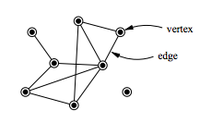
Photo from wikipedia
Spatial networking is the 'new normality' of local innovation systems, featuring a heterogeneous set of inter-organizational ties and a constant circulation of information, knowledge, practices, and other intangible assets of… Click to show full abstract
Spatial networking is the 'new normality' of local innovation systems, featuring a heterogeneous set of inter-organizational ties and a constant circulation of information, knowledge, practices, and other intangible assets of actors engaged in the regional innovation milieu. Understanding the particularities of territorial communities formed clarify the socio-spatial dynamics and the development trajectory of the region, its competitiveness and innovative potential. The study explores the variety of factors that affect the patterns of these socioeconomic interactions, such as the networking objectives, the stakeholders involved, the benefits projected, their spatial embeddedness, as to reduce the equivocality inherent to methodologies of delimitation and subsequent demarcation of spatial-network interactions. The study rests upon analysis of different types of relations formed between heterogeneous actors of regional socioeconomic system, both at inter-firm and inter-organizational level. Providing a classification of major factors that determine the features and patterns of spatial networking, the paper proceeds with discussing the differences in their dynamic configurations using three scholarly concepts – industrial district, business cluster, and global innovation network. The study revealed 20 individual typological characteristics in a group of four determining features of spatial-network interactions – the stakeholders, the linkages, the network, and the context. The typology elaborated is irrelative to the types of spatial networking analyzed, thus, being equally applicable to the modeling of different configurations of entrepreneurial interactions within the regional milieu. Territorial capital assessment requires a holistic approach in determining the socio-spatial dynamics of the regional milieu. This necessitates defragmentation of local ties into value constellations of the single regional socioeconomic and innovation system. The study contributes to the understanding of internal mechanisms of various forms of entrepreneurial networking, providing a set of criteria for integrated evaluation of spatial-network interactions.
Journal Title: Entrepreneurship and Sustainability Issues
Year Published: 2018
Link to full text (if available)
Share on Social Media: Sign Up to like & get
recommendations!